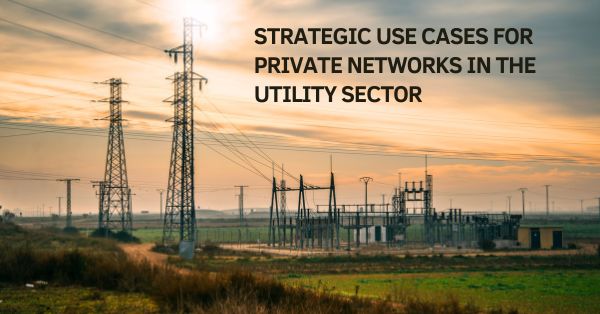Sensing Meets Connectivity: A Strategic Shift for Mobile Networks
In the past two years, wireless infrastructure has undergone some of its most significant transformations since the launch of 5G. Spectrum policy, RAN evolution, and ...
- Tech News & Insight
- June 27, 2025
- Hema Kadia
Cybersecurity is now a core pillar of utility private networks. Explore how Zero Trust Architecture helps utilities secure SCADA systems, protect distributed energy assets, and comply with NERC CIP standards, keeping critical infrastructure safe in a hybrid IT/OT world.
- Tech News & Insight
- June 27, 2025
- Hema Kadia
Utilities are turning private LTE and 5G networks into revenue engines with monetization and shared use models. Learn how Fixed Wireless Access, neutral host strategies, mobile wholesale partnerships, and edge services help utilities bridge the digital divide, support local economies, and generate ROI from advanced network investments.
- Tech News & Insight
- June 27, 2025
- Hema Kadia
Private LTE and 5G networks enable utilities to achieve sustainability and ESG goals by supporting clean energy, climate resilience, safer field operations, and transparent ESG reporting. Discover how utilities are using private networks to lower emissions, integrate renewables, and protect communities.
- Tech News & Insight
- June 27, 2025
- Hema Kadia
As utilities expand private LTE and 5G networks, strong partner ecosystems and managed services help balance performance, compliance, and cost. Explore how orchestration, governance frameworks, and co-managed models enable utilities to scale smarter and faster.
- Tech News & Insight
- June 27, 2025
- Hema Kadia
As utility private networks scale beyond pilot deployments, success depends on more than connectivity. This blog explores how utilities are applying orchestration frameworks, secure governance models, and lifecycle management strategies to build scalable, resilient, and future-ready private LTE and 5G infrastructures, ensuring long-term performance, compliance, and adaptability.
- Tech News & Insight
- June 27, 2025
- Hema Kadia
Utilities are unlocking real-time intelligence and predictive maintenance by combining edge computing and AI with private LTE/5G networks. This blog explores how utilities process critical data locally to automate decisions, detect anomalies, optimize asset performance, and improve operational resilience—laying the foundation for the autonomous grid.
- Tech News & Insight
- June 27, 2025
- Hema Kadia
Utilities are implementing private LTE and 5G networks across diverse environments—from turbine halls and substations to national grid systems. This blog outlines the key deployment architectures (site-specific, regional, wide-area, and indoor) and spectrum strategies utilities are using to deliver secure, scalable, and purpose-built connectivity for modern energy operations.
- Tech News & Insight
- June 27, 2025
- Hema Kadia
The shift to private LTE and 5G in utilities is being driven by a convergence of urgent trends, from climate mandates and cyber threats to legacy infrastructure and labor shortages. This blog explores six key forces accelerating private network adoption and highlights why resilient, intelligent, and secure communications have become essential to utility transformation.
- Tech News & Insight
- June 27, 2025
- Hema Kadia
Private LTE and 5G networks are transforming how utilities operate by enabling a wide range of mission-critical and emerging applications. From AMI and substation automation to drone inspections and edge AI, this post outlines 12 strategic use cases that demonstrate why utilities are investing in private cellular infrastructure to improve safety, performance, and operational agility across the grid.
- Tech News & Insight
- June 27, 2025
- Hema Kadia
As the energy grid becomes more distributed and digital, utilities are investing in private LTE and 5G networks to future-proof their operations. These purpose-built networks support secure, real-time communications, improve operational visibility, and enable automation, delivering the connectivity backbone required for a modern, resilient grid.
- Tech News & Insight
- June 27, 2025
- Hema Kadia
- Usecase
- June 25, 2025
- Hema Kadia
Verizon Business and Nokia will deploy six private 5G networks across Thames Freeport’s major logistics sites, including the Port of Tilbury, London Gateway, and Ford Dagenham to create a high-performance digital infrastructure supporting real-time logistics, AI automation, and edge computing. With plans to generate 5,000 skilled jobs and power sustainable trade, this initiative positions Thames Freeport as a next-gen smart trade corridor.
- 5G, AI, Automation, Edge/MEC, IoT, Private Networks
- LTE, Nokia, Private 5G, Verizon, WiFi
- Ports
- Usecase
- June 23, 2025
- Hema Kadia
Hrvatski Telekom’s NextGen 5G Airports project will deploy Private 5G Networks at Zagreb, Zadar, and Pula Airports to boost safety, efficiency, and airport automation. By combining 5G Standalone, Edge Computing, AI, and IoT, the initiative enables drones, smart cameras, and AI tablets to digitize inspections, secure perimeters, and streamline operations, redefining aviation connectivity in Croatia.
- Tech News & Insight
- June 23, 2025
- Hema Kadia
SK Group and AWS are partnering to build South Korea’s largest AI data center in Ulsan with a $5.13 billion investment. The facility will launch with 60,000 GPUs and 103 MW capacity, expanding to 1 GW, creating up to 78,000 jobs. This milestone boosts South Korea’s AI leadership, data sovereignty, and positions Ulsan as a major AI hub in Asia.
- Tech News & Insight
- June 23, 2025
- Oliver King-Smith, CEO and founder smartR AI
This article critiques the common practice of exhaustive data cleaning before implementing AI, labeling it a consultant-driven “scam.” Data cleaning is a never-ending and expensive process, delaying AI implementation while competitors move forward. Instead, I champion a “clean as you go” approach, emphasizing starting with a specific AI use case and cleaning data only as needed. Smart companies prioritize iterative improvement by using AI to fill in data gaps and building safeguards around imperfect data, ultimately achieving faster results. The core message is it’s more important to prioritize action over perfection, enabling quicker AI adoption and thereby competitive advantage.
- Podcast
- June 22, 2025
- Hema Kadia
Private 5G in South Korea is reshaping manufacturing by enabling autonomous robots, real-time quality control, and AI-driven operations. This video podcast explains how dedicated spectrum, practical deployment models, and flexible pricing help factories justify Private 5G over Wi-Fi, plus insights on scaling ROI and future AI-native networks.
- Tech News & Insight
- June 19, 2025
- Hema Kadia
Edge AI is reshaping broadband customer experience by powering smart routers, proactive troubleshooting, conversational AI, and personalized Wi-Fi management. Learn how leading ISPs like Comcast and Charter use edge computing to boost reliability, security, and customer satisfaction.
- Tech News & Insight
- June 17, 2025
- Oliver King-Smith, CEO and founder smartR AI
The pressure to adopt artificial intelligence is intense, yet many enterprises are rushing into deployment without adequate safeguards. This article explores the significant risks of unchecked AI deployment, highlighting examples like the UK Post Office Horizon scandal, Air Canada’s chatbot debacle, and Zillow’s real estate failure to demonstrate the potential for financial, reputational, and societal damage. It examines the pitfalls of bias in training data, the problem of “hallucinations” in generative AI, and the economic and societal costs of AI failures. Emphasizing the importance of human oversight, data quality, explainability, ethical guidelines, and robust security, the article urges organizations to proactively navigate the challenges of AI adoption. It advises against delaying implementation, as competitors are already integrating AI, and advocates for a cautious, informed approach to mitigate risks and maximize the potential for success in the AI era.
- Tech News & Insight
- June 23, 2025
- News Feed
A global IBM study reveals 81% of CMOs see AI as critical for growth, yet 54% underestimated the operational complexity. Only 22% have set clear AI usage guidelines, despite 64% now being responsible for profitability. Siloed systems, talent gaps, and lack of collaboration hinder translating AI strategies into results, highlighting a major execution gap as marketing leaders adapt to increased accountability for profit and revenue growth.
- Tech News & Insight
- June 17, 2025
- Hema Kadia
Elon Musk’s generative AI firm, xAI, is targeting $4.3 billion in new equity funding, following its previous $6 billion raise and a $5 billion debt effort. The capital will support high-cost AI models like Grok and Aurora, expand massive GPU-powered data centers, and drive xAI’s ambition to compete with leaders like OpenAI and DeepMind. Investors remain interested despite concerns over spending, betting on Musk’s strategy to blend social media and AI under one ecosystem.
- Tech News & Insight
- June 16, 2025
- Suyash Rai
The emergence of 6G networks marks a paradigm shift in the way wireless systems are conceived and managed. Unlike its predecessors, 6G will embed Artificial Intelligence (AI) as a native capability across all network layers, enabling real-time adaptability, intelligent orchestration, and autonomous decision-making. This paper explores the symbiosis between AI and 6G, highlighting key applications such as predictive analytics, alarm correlation, and edge-native intelligence. Detailed insights into AI model selection and architecture are provided to bridge the current technical gap. Finally, the cultural and organizational changes required to realize AI-driven 6G networks are discussed. A graphical abstract is suggested to visually summarize the proposed architecture.
- Tech News & Insight
- June 16, 2025
- Robert James Armstrong
Telecom engineers know OSS systems aren’t broken—they just pretend to work. Outdated data, broken integrations, and overwhelming alerts create false confidence and slow operations. Discover how VC4’s Service2Create delivers real-time, trusted inventory and smarter workflows that engineers can actually rely on.
- Tech News & Insight
- June 16, 2025
- Suyash Rai
As the telecom world accelerates toward 5G-Advanced and sets its sights on 6G, artificial intelligence (AI) is no longer a peripheral technology — it is becoming the brain of the mobile network. AI-driven Radio Access Networks (RANs), and increasingly AI-native architectures, are reshaping how operators design, optimize, and monetize their networks. From zero-touch automation to intelligent spectrum management and edge AI services, the integration of AI and machine learning (ML) is unlocking both operational efficiencies and new business models.
This article explores the evolution of AI in the RAN, the architectural shifts needed to support it, the critical role of Open RAN, and the most promising AI use cases from the field. For telcos, this is not just a technical upgrade — it is a strategic inflection point.
This article explores the evolution of AI in the RAN, the architectural shifts needed to support it, the critical role of Open RAN, and the most promising AI use cases from the field. For telcos, this is not just a technical upgrade — it is a strategic inflection point.
- 5G, 6G, AI, Automation, Open RAN, Private Networks, RAN
- Usecase
- June 23, 2025
- Hema Kadia
ZTE and e& UAE have completed a successful Private 5G Network trial, showcasing high uplink speeds, multi-band adaptability, and ZTE’s NodeEngine Edge Computing platform. This trial enables rapid deployment, stronger enterprise connectivity, and practical use cases for smart industries, aligning with the UAE’s goal of becoming a digital innovation leader.
- Usecase
- June 23, 2025
- Hema Kadia
The City of Istres, France, partners with Ericsson, SPIE, and Unitel to deploy a cost-efficient Private 5G Network. This smart city blueprint reduces surveillance camera installation costs by over 80%, improves secure emergency communications, and leverages Edge Computing for AI-ready urban security. Istres sets a precedent for mid-sized European cities modernizing connectivity and resilience.
Whitepaper
Telecom networks are facing unprecedented complexity with 5G, IoT, and cloud services. Traditional service assurance methods are becoming obsolete, making AI-driven, real-time analytics essential for competitive advantage. This independent industry whitepaper explores how DPUs, GPUs, and Generative AI (GenAI) are enabling predictive automation, reducing operational costs, and improving service quality....

Whitepaper
Explore the collaboration between Purdue Research Foundation, Purdue University, Ericsson, and Saab at the Aviation Innovation Hub. Discover how private 5G networks, real-time analytics, and sustainable innovations are shaping the "Airport of the Future" for a smarter, safer, and greener aviation industry....

Article & Insights
This article explores the deployment of 5G NR Transparent Non-Terrestrial Networks (NTNs), detailing the architecture's advantages and challenges. It highlights how this "bent-pipe" NTN approach integrates ground-based gNodeB components with NGSO satellite constellations to expand global connectivity. Key challenges like moving beam management, interference mitigation, and latency are discussed, underscoring...

Download Magazine
With Subscription
Subscribe To Our Newsletter
Executive Interviews
Add your news and insights
Submit Guest Posts and Press Releases
Brand Connect
Amplify Your Brand & Boost Your Business
- Thought-Leadership Management
- Magazine Article
- Executive Interviews
- Whitepapers
- Research Reports
- Custom Research
- Blog Series
- Webinars
- Podcasts
- Advertorials
- Display Ads
- Event Partnership









































